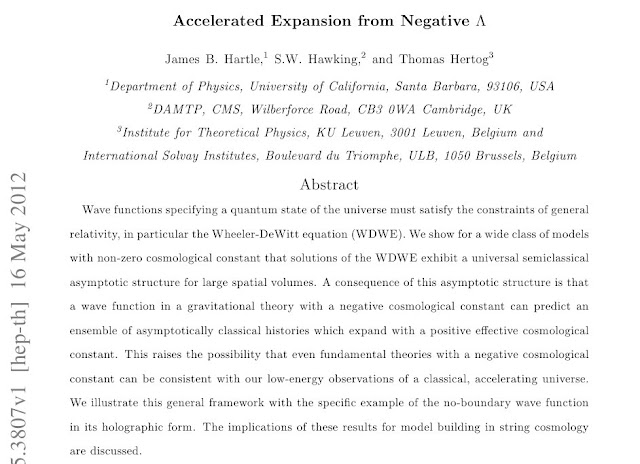 |
| http://arxiv.org/abs/1205.3807 |
About 10 years ago, gravitational physics, cosmology and high-energy physics witnessed two orthogonal revolutions, both related to the cosmological constant, "Einstiein's biggest blunder".
On the one hand, in 1998 some observations of Type Ia supernovae were announced, which indicated that the Universe is accelerating in its expansion. The most natural (and somehow easiest) way to accommodate these observations, together with measurements of the cosmic microwave background (CMB) radiation, is to allow for a small and positive cosmological constant (by "small" here we mean 10^{-123} in Planck units!). Actually, there are many other problems (generically referred to as "The Cosmological Constant Problem") that follow from this ridiculous smallness. But this is topic for another post.
On the other hand, at about the same time, in late 1997, Juan Maldacena proposed one of the most revolutionary ideas in high-energy physics of all time. His (as well Witten's, t'Hooft, Sussking, Gubser's and many others) idea is now known as AdS/CFT correspondence, gauge/gravity duality, Maldacena's conjecture etc... This can easily be the topic of another post too (by the way, apparently it's also the topic of 8283 papers citing Maldacena's orginal work to date). What is important now for the remaining is "just" that the ingredients of the AdS/CFT duality are two (a priori completely different) entities: 1) a gravitational theory in Anti de Sitter spacetime in D dimensions and 2) a gauge theory without gravity living on the boundary of this spacetime, i.e. in D-1 dimension.
Naively, Anti de Sitter space means negative cosmological constant, whereas a positive cosmological constant (as that suggested by observations) is related to a de Sitter metric.
Nowadays, the accelerating expansion of the Universe and the AdS/CFT correspondence are two of the most active research fields in physics. That is to say, what Einstein considered as his greatest failure (i.e. having introduced the cosmological constant in his equations) turned out to be revolutionary both in cosmology and in theoretical physics, but for different reasons, because observations require a positive cosmological constant, while Maldacena's idea calls for a negative one.
So, are cosmological observations and high-energy theoretical studies completely disjointed?
There would be nothing drammatic in answering affermatively, since both research fields have their own right and proved to be of fundamental relevance.
However, what is amazing is that, as triple-H (not this one, but Hartle, Hawking and Herzog) showed in their paper, the answer to this question could be no!
Indeed, quantum effects can produce a semiclassical cosmology describing an accelerating and expanding Universe, even if the fundamental quantum gravity theory is defined in an Anti de Sitter space! That is, we might well see an "effective" positive cosmological constant, which is quantum-generated from a theory where the "bare" cosmological constant is negative... I wish i could say more on this, if only i could understand the paper :) [i promise: studying it is on the ToDo list, in my partial defense, the authors do not need presentation...].

No comments:
Post a Comment